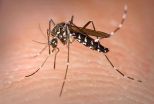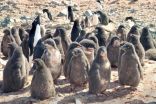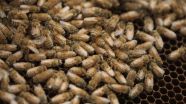(Press-News.org) NASA's Terra satellite spotted a "zombie" tropical storm as Halloween week kicks off. Tropical Depression 9 made landfall in Mexico's Yucatan Peninsula late last week and lingered as a remnant low pressure area on Saturday and Sunday, Oct. 25 and 26. Satellite data revealed that those remnants had reformed quickly and jumped up to tropical storm status, where it became "zombie" storm named Tropical Storm Hanna off the coast of Nicaragua. NASA's Terra satellite spotted strong thunderstorms around the zombie storm's center as it passed overhead.
At 9:30 a.m. EDT on Oct. 27, the National Hurricane Center (NHC) issued a tropical storm warning for Punta Patuca, Honduras southward to Puerto Cabezas, Nicaragua. A tropical storm warning means that tropical storm conditions are expected somewhere within the warning area...in this case within the next 6 to 12 hours. The National Hurricane Center noted that tropical storm conditions are expected within the warning area through this evening. In addition, Hanna could produce 10 to 12 inches (250 to 300 mm) of rain, with isolated maximum amounts of 15 inches (400 mm), across Honduras and northern Nicaragua. These rainfall Amounts will produce life-threatening flash floods and mudslides.
NASA's Terra satellite passed over Tropical Storm Hanna on Oct. 27 at 03:45 UTC (Oct. 26 at 11:45 p.m. EDT) and the Moderate Resolution Imaging Spectroradiometer or MODIS instrument gathered infrared data on the storm. The MODIS instrument showed high thunderstorms around the newly reformed center of circulation with cold cloud top temperatures near -63F/-53C that indicated they were high in the troposphere. Those strong thunderstorms have the potential to drop heavy rainfall.
Forecaster Berg at NHC noted that Hanna's center is very close to the coast of northeastern Nicaragua and moving to the west-southwest. Hanna is expected to make landfall and move inland over Nicaragua by late today, Oct. 27.
At 10 a.m. EDT, Hanna's center was near 14.5 north latitude and 83.2 west longitude. That's about 35 miles (60 km) north-northeast of Puerto Cabezas, Nicaragua, and about 35 miles (55 km) south of Cabo Gracias a Dios on the Nicaragua/Honduras border. Hanna was moving toward the west-southwest near 7 mph (11 kph) and is expected to continue in that direction for the next day or two. Maximum sustained winds were near 40 mph (65 kph) and little change in strength is expected before landfall, followed by weakening as it moves inland.
INFORMATION:
Rob Gutro
NASA's Goddard Space Flight Center
NASA sees a 'Zombie' tropical storm kick off Halloween week
2014-10-27
ELSE PRESS RELEASES FROM THIS DATE:
Ultrasound guides tongue to pronounce 'r' sounds
2014-10-27
Using ultrasound technology to visualize the tongue's shape and movement can help children with difficulty pronouncing "r" sounds, according to a small study by NYU's Steinhardt School of Culture, Education, and Human Development and Montclair State University.
The ultrasound intervention was effective when individuals were allowed to make different shapes with their tongue in order to produce the "r" sound, rather than being instructed to make a specific shape. The findings appear online in the Journal of Speech, Language, and Hearing Research.
The "r" sound is one ...
Slowing the biological clock
2014-10-27
Difficulty in conceiving a child is a major challenge for one in seven heterosexual couples in America, especially for those over the age of 35. Now a new discovery by researchers at Tel Aviv University and Chaim Sheba Medical Center at Tel Hashomer could boost the chances of conception in women undergoing in vitro fertilization (IVF) treatments.
Their new research reveals a linkage between the genes of the innate immune system — immunity with which human beings are born, rather than immunity they acquire during their lives — and ovarian longevity. The study, ...
'Sticky' ends start synthetic collagen growth
2014-10-27
Rice University researchers have delivered a scientific one-two punch with a pair of papers that detail how synthetic collagen fibers self-assemble via their sticky ends.
Collagen is the most common protein in mammals, a major component of bone and the fibrous tissues that support cells and hold organs together. Discovering its secrets may lead to better synthetic collagen for tissue engineering and cosmetic and reconstructive medicine.
The Rice lab of Jeffrey Hartgerink has been studying synthetic collagen for a decade, teasing out the details of how it starts as three ...
Hot on the trail of the Asian tiger mosquito
2014-10-27
The Asian tiger mosquito (Aedes albopictus), which is native to Southeast Asia, was spotted in Houston in 1985. By 1986 it had reached St. Louis and Jacksonville, Fla. Today it can be found in all of the southern states and as far north as Maine.
An aggressive daytime biter, Ae. albopictus has an affinity for humans and is also a vector for human disease, said Kim Medley, PhD, interim director of the Tyson Research Center at Washington University in St. Louis.
The mosquito arrived in the U.S. in a shipment of used tires from Japan. Ae. albopictus lays eggs that can ...
University of Delaware study connects penguin chick weights to local weather conditions
2014-10-27
Adélie penguins are an indigenous species of the West Antarctic Peninsula (WAP), one of the most rapidly warming areas on Earth. Since 1950, the average annual temperature in the Antarctic Peninsula has increased 2 degrees Celsius on average, and 6 degrees Celsius during winter.
As the WAP climate warms, it is changing from a dry, polar system to a warmer, sub-polar system with more rain.
University of Delaware oceanographers recently reported a connection between local weather conditions and the weight of Adélie penguin chicks in an article in Marine Ecology ...
Cost of informal caregiving for US elderly is $522 billion annually, study finds
2014-10-27
The price tag for informal caregiving of elderly people by friends and relatives in the United States comes to $522 billion a year, according to a new RAND Corporation study.
Replacing that care with unskilled paid care at minimum wage would cost $221 billion, while replacing it with skilled nursing care would cost $642 billion annually.
The study, published online by the journal Health Services Research, improves on earlier estimates about the value of informal caregiving by making use of the 2011 and 2012 American Time Use Survey, a new and unique database, to provide ...
PET scans reveal how psychodynamic therapy for depression may change brain function
2014-10-27
A study from Massachusetts General Hospital (MGH) investigators has identified for the first time changes in the metabolic activity of a key brain region in patients successfully treated for depression with psychodynamic psychotherapy, suggesting a mechanism of action behind one of the most historically important and widely practiced forms of therapy. They also found evidence that pretreatment metabolism in a different brain structure might predict which patients are likely to respond to that form of therapy. Their report will appear in the journal Psychotherapy and Psychosomatics ...
Blood vessel growth in the brain relies on a protein found in tumor blood vessels
2014-10-27
Do blood vessels that feed tumors differ from other blood vessels? Fourteen years ago, experiments designed to answer that question led to the discovery of several genes that are more active in tumor-associated blood vessels than in normal blood vessels. New research now reveals the normal function of one of those genes and suggests it could be a good target for anticancer drug therapy.
A summary of the research appears in the journal Developmental Cell on Oct. 27.
The mystery of the gene, TEM5, began in 2000 with research conducted by Brad St. Croix, Ph.D., working ...
Using microscopic bugs to save the bees
2014-10-27
For decades, honeybees have been battling a deadly disease that kills off their babies (larvae) and leads to hive collapse. It's called American Foulbrood and its effects are so devastating and infectious, it often requires infected hives to be burned to the ground.
Treating Foulbrood is complicated because the disease can evolve to resist antibiotics and other chemical treatments. Losing entire hives not only disrupts the honey industry, but reduces the number of bees for pollinating plants.
Now researchers at BYU have produced a natural way to eliminate the scourge, ...
Group classes teach parents effective autism therapy, Stanford/Packard study finds
2014-10-27
Parents can learn to use a scientifically validated autism therapy with their own children by taking a short series of group classes, a new study by researchers at the Stanford University School of Medicine and Lucile Packard Children's Hospital Stanford has found.
The therapy helped children improve their language skills, an area of deficiency in autism, according to the study, which will be published Oct. 27 in the Journal of Child Psychology and Psychiatry. The study is the first randomized, controlled trial to test whether group classes are a good way to train parents ...




